User:SeismicShrimp/sandbox
Appearance
(Edit of current page)
[edit]Mammals
[edit]Partially based on Grande (1984). Aside from the few well-preserved mammals found in Fossil Lake, a majority of Green River mammals are based on isolated bones and teeth:[1]
Metatheria
[edit]| Genus | Species | Member | Abundance | Notes | Image |
|---|---|---|---|---|---|
| Herpetotherium | H. innominatum | Lake Gosiute, Lake Uinta, & Douglas Creek | An opossum-like basal metatherian. Originally placed in Peratherium. | 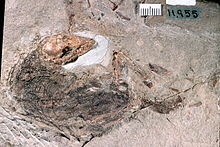 | |
| H. knighti | Lake Gosiute | ||||
| H. marsupium | Douglas Creek | ||||
| Peradectes | P. chesteri | Douglas Creek |  | ||
| Armintodelphys | A. dawsoni | Douglas Creek |
Artiodactyla
[edit]| Genus | Species | Member | Abundance | Notes | Image |
|---|---|---|---|---|---|
| Antiacodon | A. pygmaeus | Douglas Creek |
Cimolesta
[edit]| Genus | Species | Member | Abundance | Notes | Image |
|---|---|---|---|---|---|
| Coryphodon | C. sp. | Douglas Creek |  | ||
| Palaeosinopa | P. didelphoides | Fossil Lake | A pantolestid. | 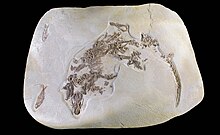 | |
| Trogosus | T. sp | Douglas Creek | 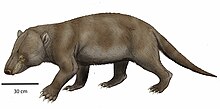 | ||
| Undescribed | Undescribed | Fossil Butte |
Chiroptera
[edit]| Genus | Species | Member | Abundance | Notes | Image |
|---|---|---|---|---|---|
| Ageina | Cf. A. sp. | Douglas Creek | |||
| Icaronycteris | I. gunnelli | Fossil Lake | 2 skeletons.[2] | An icaronycterid bat. | 
|
| I. index | 
| ||||
| Onychonycteris | O. finneyi | An onychonycterid bat. | 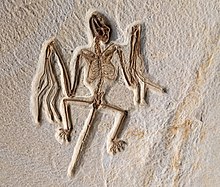
|
Eulipotyphla
[edit]| Genus | Species | Member | Abundance | Notes | Image |
|---|---|---|---|---|---|
| Centetodon | C. pulcher | ||||
| C. bembicophagus | |||||
| Nyctitherium | N. nitidum | Lake Gosiute | A nyctitheriid. Originally identified as Talpavus nitidus. | ||
| N. priscum | Douglas Creek | ||||
| N. serotinum | Douglas Creek | ||||
| N. sp. | Lake Uinta | ||||
| Scenopagus | S. edenensis | Douglas Creek |
Pan-Carnivora
[edit]| Genus | Species | Member | Abundance | Notes | Image |
|---|---|---|---|---|---|
| "Miacis" | "M." gracilis | Lake Uinta | A carnivoraform of uncertain affinities. | ||
| Sinopa | S. minor | Lake Uinta | A sinopid hyaenodont. |  | |
| Viverravus | V. minutus | Lake Uinta | A viverravid. | 
| |
| Vulpavus | V. profectus | Lake Gosiute | A miacid. | 
|
Pan-Perissodactyla
[edit]| Genus | Species | Member | Abundance | Notes | Image |
|---|---|---|---|---|---|
| Helaletes | H. nanus | Douglas Creek | |||
| Hyopsodus | H. minusculus | Lake Gosiute & Lake Uinta | A hyopsodontid. | ||
| H. paulus (=H. vicarius) | Lake Uinta | ||||
| H. wortmani | Fossil Lake | 
| |||
| Hyrachyus | H. modestus | Douglas Creek | |||
| Hyracotherium | H. vasacciense | Douglas Creek | |||
| Isectolophus | I. sp. cf. l. latidens | Douglas Creek | |||
| Lambdotherium | L. popoagicum | Fossil Lake | A small-sized basal brontothere. | 
| |
| Protorohippus | P. venticolus | 2 skeletons. | An equid. | 
| |
| Tapiromorpha indet. | 1 skeleton | A juvenile tapiromorph, the largest mammal specimen known from the formation. Initially identified as a Heptodon calciculus.[3] |
Apatotheria
[edit]| Genus | Species | Member | Abundance | Notes | Image |
|---|---|---|---|---|---|
| Apatemys | A. sp., cf. A. bellus | Douglas Creek | |||
| A. sp., cf. A. bellulus | Douglas Creek | ||||
| A. chardini | Fossil Lake & Douglas Creek | ||||
| A. sp., cf. A. rodens | Douglas Creek |
Rodentia
[edit]| Genus | Species | Member | Abundance | Notes | Image |
|---|---|---|---|---|---|
| Paramys | P. sp. | Lake Uinta | A ischyromyid rodent. |  | |
| Sciuravus | S. eucristadens | Lake Uinta | A sciuravid rodent. Originally identified as Viverravus eucristadens. | ||
| S. sp. | |||||
| Thisbemys | T. sp. | Lake Gosiute | A ischyromyid rodent. | 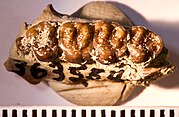 |
Primatomorpha
[edit]| Genus | Species | Member | Abundance | Notes | Image |
|---|---|---|---|---|---|
| Microsyops | M. elegans | Lake Gosiute | A microsyopid stem-primate. | 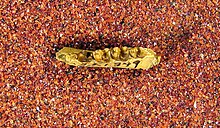 | |
| Notharctus | N. sp. | Lake Gosiute | A notharctid adapiform. |  | |
| Omomys | O. carteri (=O. pucillus)[4] | Lake Uinta | An omomyid primate. | ||
| Smilodectes | S. gracilis | Lake Uinta | A notharctid adapiform. Formerly placed in Notharctus matthewi. | 
| |
| Tetonius | T. sp. | Lake Uinta | An omomyid primate. |  | |
| Uintasorex | U. parvulus | Lake Gosiute | A microsyopid stem-primate. | ||
| Washakius | W. insignis | Lake Gosiute | An omomyid primate. | 
|
- ^ Cite error: The named reference
:3was invoked but never defined (see the help page). - ^ Rietbergen, Tim B.; Ostende, Lars W. van den Hoek; Aase, Arvid; Jones, Matthew F.; Medeiros, Edward D.; Simmons, Nancy B. (2023-04-12). "The oldest known bat skeletons and their implications for Eocene chiropteran diversification". PLOS ONE. 18 (4): e0283505. Bibcode:2023PLoSO..1883505R. doi:10.1371/journal.pone.0283505. ISSN 1932-6203. PMC 10096270. PMID 37043445.
- ^ "Wyoming State Geological Survey - Tapiromorph Fossil". main.wsgs.wyo.gov. Retrieved 2024-09-04.
- ^ Burger, Benjamin John (2010-06-21). "Paleontological Contributions no. 2: Skull of the Eocene primate Omomys carteri from western North America". Paleontological Contributions (2). doi:10.17161/PC.1808.6360. ISSN 1946-0279.

